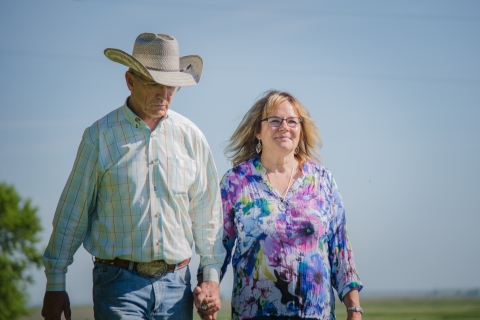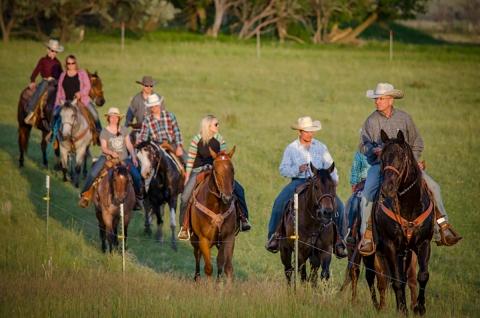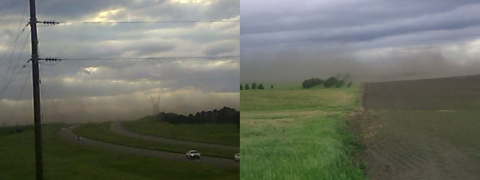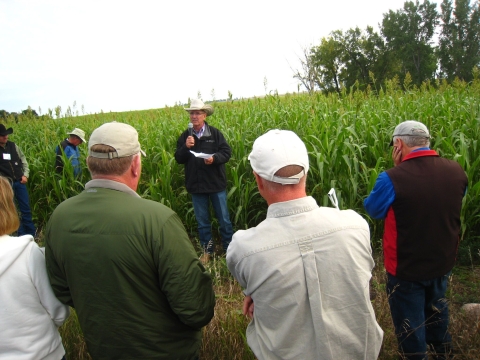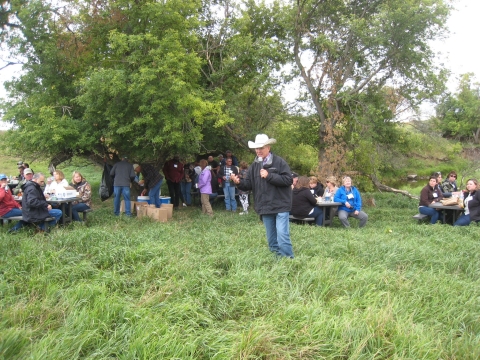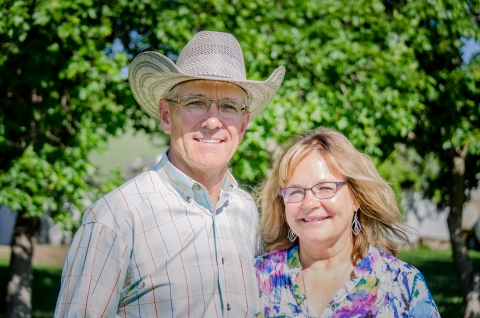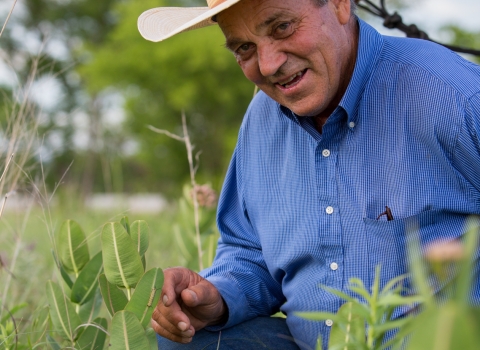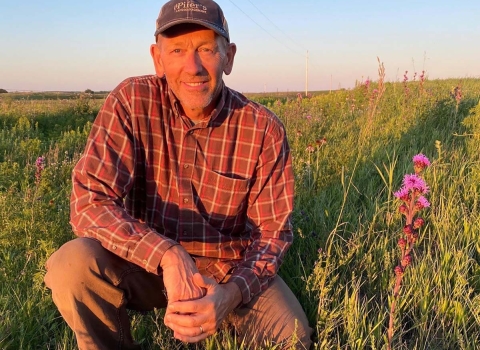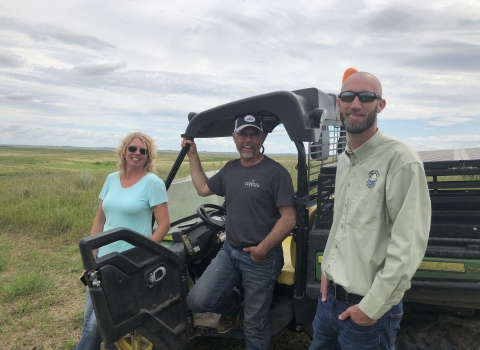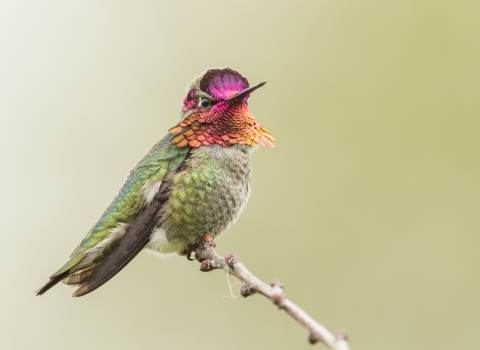“We are losing our grasslands. We need to be honest with ourselves and with one another if we’re going to fix this.”
Jerry Doan has been involved in the operation of Black Leg Ranch, southeast of Bismarck, North Dakota, for 48 years and is a longtime leader in his community, having previously served in leadership roles for several agricultural and community organizations. He currently serves as president and a mentor for the North Dakota Grazing Lands Coalition and is a member of several advisory boards, including the North Dakota Natural Resources Trust, Partnerscapes, and The Nature Conservancy.
During his time as a landowner and community leader, Jerry has slowly watched the grasslands of North Dakota disappear. According to recent estimates, 23-25% of North Dakota’s native grasslands remain. More than 80% of grasslands have been lost nationwide due to factors such as agricultural conversion, tree encroachment, and the spread of invasive species invasive species
An invasive species is any plant or animal that has spread or been introduced into a new area where they are, or could, cause harm to the environment, economy, or human, animal, or plant health. Their unwelcome presence can destroy ecosystems and cost millions of dollars.
Learn more about invasive species , all of which are further intensified by disruptions to local and global climate patterns. Healthy grasslands play a critical role in a landscape’s resiliency against drought, flooding, wildfire, and soil erosion, while providing key ecological services for wildlife, water quality, and biodiversity.
Over the years, Jerry has seen a decline in appreciation for native grasslands, partly driven by a cultural focus on other ecosystems like forests, coasts, and oceans. But Jerry wants people to see the value and cultural heritage of our nation’s grasslands. “We have lost our collective understanding of soil health awareness and land stewardship, and we’ve forgotten what our grasslands used to look like. Grizzly bears used to roam the great plains as far south as Mexico. I don’t think people realize that these days, we’ve just forgotten so much of our history.”
“There is nobody alive today that knows what our grasslands should look like. All we have are written accounts,” added Chad Maier, biologist for the Service’s Partners for Fish and Wildlife program. The landscape has changed drastically over the last two centuries, starting with the westward expansion of American settlers and the ensuing transformations as populations boomed in the 19th and 20th centuries. As part of these landscape-scale changes, the large swaths of pristine prairie have been replaced with cultivated lands, and that trend continues today. As the widespread loss of grasslands expands through the region, more and more of North Dakota’s grasslands continue to disappear.
Across North Dakota, most remaining grasslands can be found on marginal, highly erodible soils that, when converted to cropland, are more prone to wind erosion, something that oftentimes manifests itself in the form of dust storms.
A leading driver of the loss of native grasslands has been conversion for agricultural crop production, something Jerry has seen firsthand in his community. “The draw of crop agriculture is so lucrative; people are buying up the land to plant crops, and in many cases with little understanding of soil health.” The balance between the need to produce food and conserve natural landscapes is a difficult one to strike, but according to Doan and many other landowners, it is a balance we nonetheless must find if we are to stop the widespread loss of our grasslands.
“The conversion of grasslands into cropland started with homesteading in the 1800s,” Jerry explained. “Landowners were required by the Homestead Act to cultivate their land. This created the public perception that land improvement inherently meant croplands.” The Homestead Act “accelerated the settlement of the western territory” by allowing families to purchase up to 160 acres of public land, with the stipulation that the landowners reside upon or cultivate the land for five years. “In addition, many bankers required landowners to break up their land for crop agriculture in order to secure operating loans,” Maier added. “Now, many of those landowners are working with the Service to restore their grasslands.”
In his role as a community leader, Jerry has become an advocate for ranching and soil health and is trying to raise awareness about the risks of widespread cultivation in this ecosystem. “Due to these historical pressures and modern crop insurance, many landowners are taking risks that they wouldn’t normally take. We are seeing total conversion of former pasture and many new landowners are not producing successful crops, but their personal losses are mitigated. Instead, the ecosystem feels the loss. We have seen landowners come in, try to cultivate their land, and when that doesn’t work like they expected, they leave. The government puts trillions of dollars into cropland agriculture, but much of the risk to what is inherently a risky business has been removed.”
Jerry also believes that the public perception that livestock, and particularly cattle, are environmentally destructive is also adding to the belief that grasslands are wastelands. “People focus on the methane production of cattle and then they think that the production of beef is detrimental to the planet – but that’s just not true. People have been misled; the message has been skewed unfairly to cast cattle production in a bad light. What we don’t talk about are the climate consequences of removing cattle from our grasslands. We can’t remove cattle without losing good grassland. If we do, the climate impact will be much more significant than the impact of methane emissions from cattle. The losses of carbon that we see when cattle are removed and replaced by cropland are immeasurable. I have seen neighbors remove their cattle, only to lose their land a few years later to erosion and poor soil health.”
While it is difficult to accurately estimate the carbon loss in cultivated soils, the U.S. Department of Agriculture estimates that conversion to agriculture can lead to a 30-50% loss of carbon stored in soil, primarily driven by soil disturbance. According to the JV8 Central Grasslands Conservation Initiative, an average of 2 million acres of grassland are lost each year. “Recent estimates of agricultural conversion and grassland protection in the Northern Great Plains suggest grassland loss is occurring five times faster than grasslands can be protected.” This has led to a decline in the amount of carbon stored inside the soil. Increasing regenerative ranching on grasslands contributes to the restoration of important ecological processes and, in turn, has the potential to allow for even more carbon capture and storage. While forests store carbon above-ground and are highly susceptible to wildfires, grasslands are better-protected from wildfires by storing carbon deep in the soil.
“We can solve many of our environmental concerns with grazing, and here at Black Leg, we can prove it,” says Jerry. “With rotational grazing and regenerative grazing, we have better soil and grass, drought resistance – our moisture goes into the ground. When I was a kid, the standard practice was season-long grazing, which left nothing on the ground. This is where some of the negative perceptions of grazing stemmed from – but there are important differences between bad grazing practices and more sustainable practices, like regenerative grazing. I am trying to educate people on these differences.” And Jerry has seen an increased demand for education and ecological awareness. “Younger generations want to know where our food comes from. I’ve seen increased demand for grass-fed meat.”
Jerry does recognize the concerns that many people have about the methane emissions produced by cattle, but he sees cattle as part of the solution. “Historically, bison produced methane when there were millions of animals, but they had natural rotational processes. They would go years between grazing the same land, which prevented over-grazing. The ruminant animals kept the grass and soil healthy. Through regenerative grazing, we can solve the climate problem through natural carbon sequestration in the soil. We’ve been keeping carbon in the soil for decades without knowing it.”
“We see the same benefits here at Black Leg; our ranch now has two streams, rich with plants and aquatic species. Our ranch produces beef on bird-friendly land because we have created a healthy, thriving ecosystem. We have seen that soil health means forage health, which leads to animal health for both cattle and wildlife.”
“Everyone loves seeing wildlife, whether we hunt or not. This is serious, we are going to lose our grasslands – and the wildlife and resilience against drought, flooding, and fire along with them – if we don’t do something. We need to be honest with ourselves and with one another – beating around the bush isn’t going to help. If we don’t talk about it, we aren’t going to solve this. Politics aside, let’s just do the right thing.”
Just as with conservation, this story was a product of collaboration with our partners and colleagues across the country. Written by Christina Stone in collaboration with Chad Maier, Scott McLeod, Katie Nuessly, John Carlson, Laura Jenkins, Matt Trott, and - with special thanks – Jerry and Renae Doan
